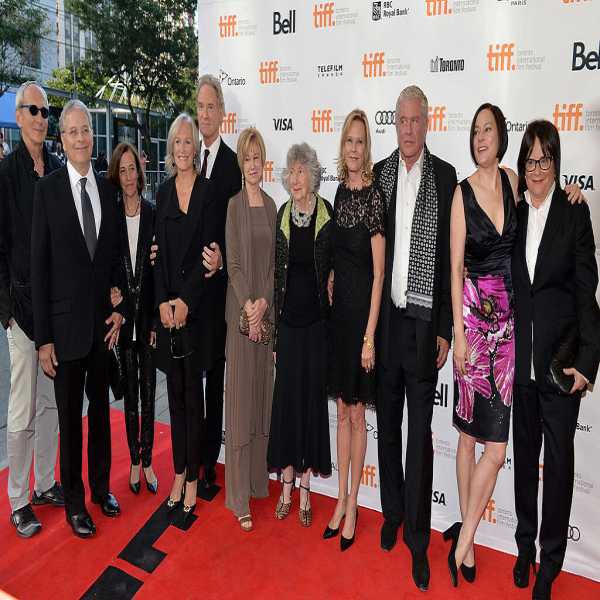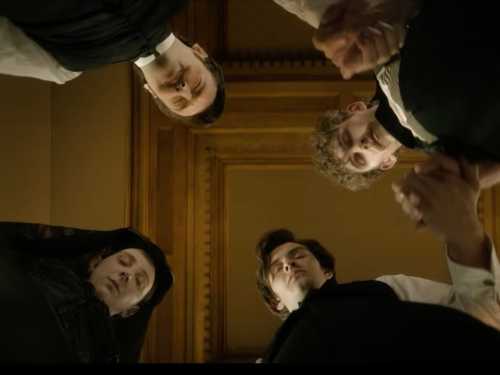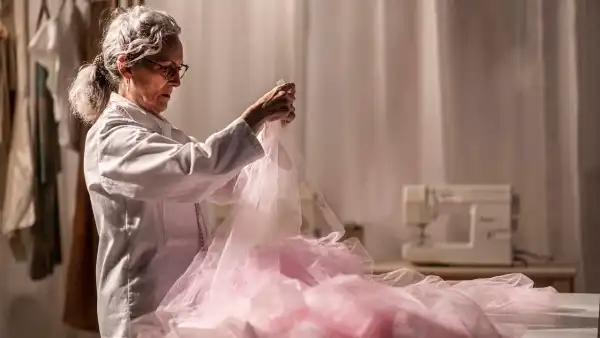The Big Chill, 40 years on, reveals a generation in all its (vain) glory.

Photo by Alberto E. Rodriguez/Getty Images
When I was a teenager, one of my favorite albums was my father’s copy of the soundtrack from the 1983 movie The Big Chill. Booming from my father’s cassette player came Marvin Gaye, Smokey Robinson and the Temptations, the Rascals, the Steve Miller Band, the Spencer Davis Group, Aretha Franklin, and Creedence Clearwater Revival—a veritable battery of the best of rock, Motown, and R&B from the ’60s and ’70s. I so adored Percy Sledge’s rendition of “When a Man Loves a Woman” that my wife and I danced to it at our wedding.
Growing up in the 1990s, the photo on the soundtrack intrigued me: I recognized Kevin Kline, Glenn Close, William Hurt, Tom Berenger, and, of course, Jeff Goldblum of Jurassic Park fame. Some of the other actors, such as Mary Kay Place and JoBeth Williams, saw their stars dim in the years after the film. Kevin Costner was supposed to have a small role, but his scenes were deleted. I remember asking my father what the movie was about. He shrugged. “A bunch of former hippies get together for a weekend after one of their old college friends kills himself. It’s a midlife crisis movie.”
That seemed to me, even as an adolescent, a bit out of sync: Some of the best music of a generation, and the storyline is just a bunch of people of my father’s age hanging out? When I watched the movie many years later, I saw that my father’s description was not far off. Fifteen years removed from their graduation from the University of Michigan, four men and three women plus the deceased’s young ballerina girlfriend spend a weekend in South Carolina, drinking, doing drugs, watching college football, and struggling to reconcile their bourgeois—and in the case of Berrenger’s Hollywood actor character, celebrity—lifestyles with their now distant youthful idealism.
It’s about as vapid and exculpatory as it sounds. In its narcissism, hedonism, and skepticism towards the American culture and economy its characters hypocritically enjoy, The Big Chill is the last word on the course of a generation and its incoherent mores. It’s too bad Lawrence Kasdan, the writer and director, didn’t realize that he was making a condemnation.
Christianity, unsurprisingly, is viewed as dull, irrelevant, and erroneous. Perhaps to emphasize this opinion—though it makes little narrative sense—the friend’s funeral is held at a rural Baptist church. The pastor’s eulogy is so stultifyingly formulaic that one of the female characters silently (and obviously skeptically) mouths the predictable words as he preaches them. In a not-so-subtle rejection of the doctrine of sin, Kline’s character ascends to the podium and declares the deceased, Alex, was “too good for this world.” Jo Beth Williams’ character concludes the ceremony by playing not a traditional hymn, but Alex’s favorite song: the Rolling Stones’ “You Can’t Always Get What You Want.” Foreshadowing trends Tara Isabella Burton explores in her book Strange Rites, in the absence of objective religious convictions, the characters mimic transcendent experiences through self-exploration.
And what better way for boomers to explore “spirituality” and meaning than via the Kerouacian consumption of various narcotics, which begins, at least in one case, on the car ride from the funeral to the cemetery. After the burial, the troupe makes their way to the married Kline and Close’s characters’ charming Southern home for a weekend together. An atmosphere of nostalgia and a reimagined youth reign supreme—not so different from the Villages—as the characters play pickup football in the yard, dance to the Oldies, and, of course, smoke copious amounts of weed.
Yet, a mood of melancholy hangs over the attendees, not only because of the loss of their friend, but what his tempestuous, supposedly ideologically pure life (and death) say about them. During a walk in the woods Kline and Goldblum’s character’s recall their college days as “two revolutionaries,” when they believed “property was a crime.” But Kline is now a successful businessman and property owner, while Goldblum is a writer of trivial fluff pieces for People magazine. “Was it all just fashion?” asks Goldblum, channeling the self-doubts of a generation.
Exemplifying a clinical lack of self-awareness, the friends complain about how the real world is a cynical place full of manipulative and opportunistic people. William Hurt’s character was made impotent by a wound suffered during the Vietnam War; he is now a drug addict and pusher. Berenger’s character is divorced, with a daughter he rarely sees—he tired of marriage with its monotonous obligations. Williams’ character gave up a promising career as a writer to have a family and is now beholden to her thoroughly square husband’s “superficial” life, as she calls it. Place’s character is a successful real estate attorney who jettisoned her idealistic, Huey P. Newton–inspired desire to be a public defender because a lot of her clients were (surprise!) contemptible criminals. But at least these friends have each other.
That theme is most fully realized in the most controversial storyline in The Big Chill. Place’s character has had trouble finding a man, frustrating her “ticking biological clock.” Over the weekend, she propositions Berenger’s and Hurt’s characters to father her child—they have “good genes”—but is rebuffed by both men. That’s where Close’s character comes to the rescue. She persuades her husband, Kline’s character (the quintessential Southern gentleman), to sleep with her best friend. It is, we’re exhorted to believe, a supreme act of love and sacrifice that exemplifies what true friendship is all about: sex.
Nor is that the only “redemptive” sexual encounter that final evening in the house. Berenger and Williams’ characters, frustrated by their lives but feeling mutually understood, rekindle (albeit briefly) an old flame. The aggrieved and adrift Vietnam vet and the young ballerina do something physical—it’s not entirely clear what given he’s supposed to impotent—but the result is that both feel a new sense of companionship and hope.
As far as the Boomer worldview goes, it’s a fitting denouement to the weekend. Free love, the hippie generation told themselves, can solve everything. Yet all the awkward questions stemming from fleeting sexual encounters remain unanswered. Williams’ character will have to go back to her now cuckolded husband—does she feel remorse? Will she leave him and the kids? Place’s character, even if she does get pregnant by her friend’s husband, will raise a child on her own. Will she tell the child that he or she is the result of a brief fling with an old friend who was “gracious” enough to impregnate her? Will that friend send birthday gifts? Will there be regular visits? In a style representative of the sexual revolution, the unsatisfying and disturbing effects of “free love”—which is never truly free—are quietly avoided.
Of course, modern science has made such scenarios less personal, if no less ethically fraught. If you’re having trouble conceiving, you can have your spouse, a friend, or even a complete stranger provide the necessary biological goods via in vitro fertilization—earlier this year a Dutch sperm donor who sired more than 500 children was ordered by a court to stop his “generosity.” What in the 1980’s era of The Big Chill required an act of misconceived “sacrifice” is now thoroughly commodified, as is much else about sex. Indeed, even the movie’s talk of “good genes” intimates that an instrumentalist, utilitarian view of sex was already implicitly present in the Boomer imagination. To the degree that sex involves the creation of children, it regards them as bespoke, quasi-technological eugenic products; otherwise, far from serving to renew the bond of marriage (how dull and constricting, especially when your spouse is such a square!), it’s simply there to make us feel good.
Subscribe Today Get daily emails in your inbox Email Address:
But do we? “I haven’t met many happy people in my life. How do they act?” asks the ballerina, in perhaps the most honest moment of the film. For all the Boomers’ altruistic aspirations and youthful vigor, they rebelled against their own rich cultural inheritance—Hurt’s character at one point declares, “No one had a cushier birth than us!” That rebellion, in turn, precluded the now deracinated Boomers from possessing the spiritual and intellectual resources required to secure true happiness. Indeed, The Big Chill shows how many hippies ended up becoming the very thing they despised: self-aggrandizing, materialistic bourgeois professionals. Hence the deep dissatisfaction—at least their parents believed in the American dream.
The great mystery of The Big Chill is why Alex killed himself. It’s never resolved. As far as the viewer can tell, Alex’s death, like his hedonistic life, was more or less meaningless: the last of a series of emotive, pseudo-intellectual choices that emulate, and eventually realize self-immolation. Perhaps that’s a fitting description of the counterculture generation and the cultural inheritance bequeathed to their descendants, who are even more skeptical of America and its traditions.
But hey, at least the music was good.
Sourse: theamericanconservative.com






